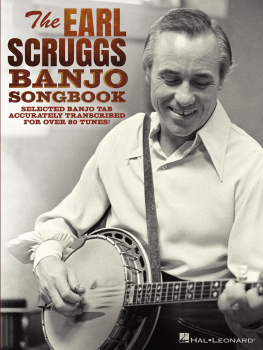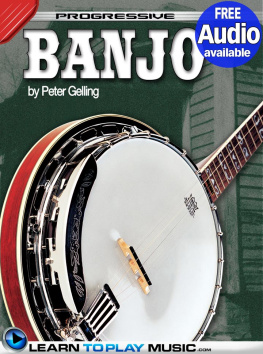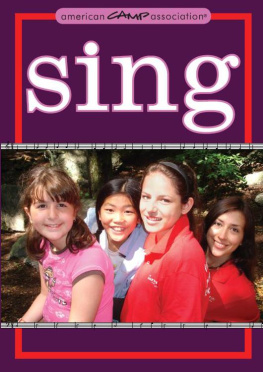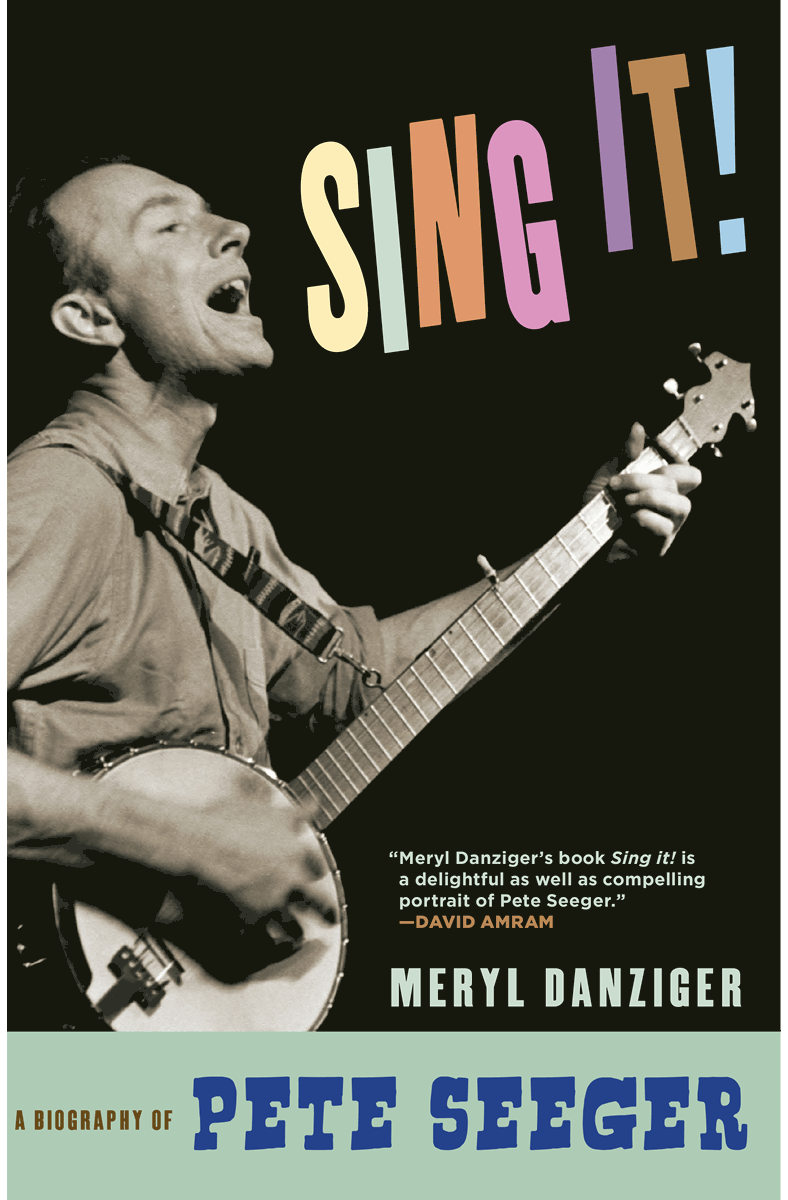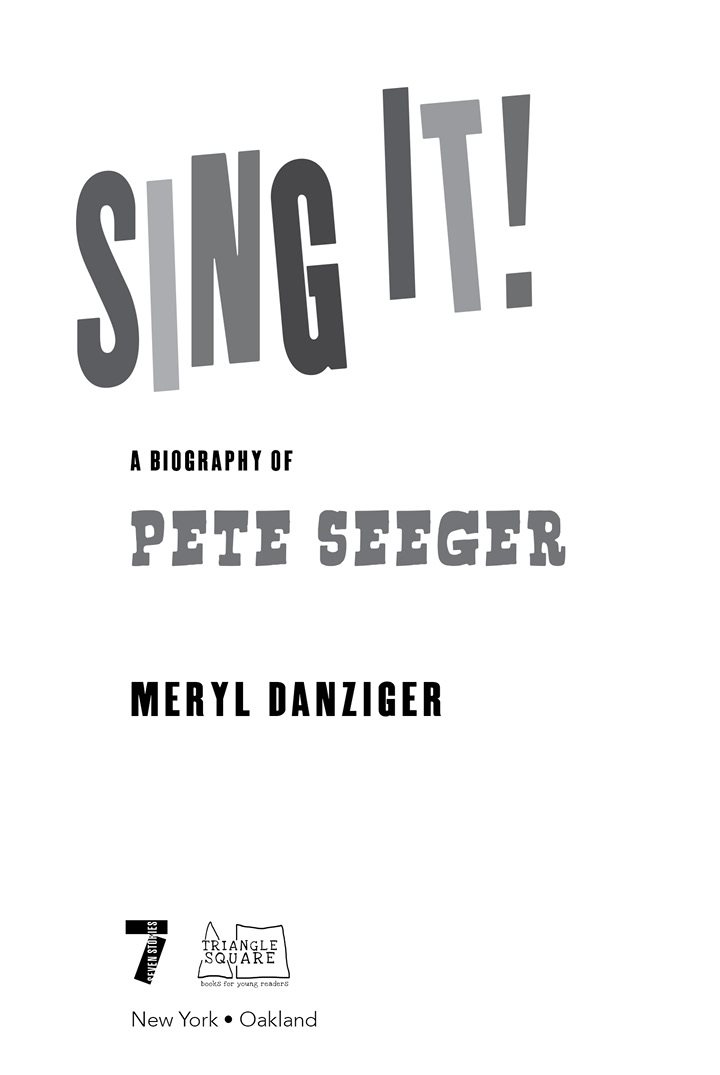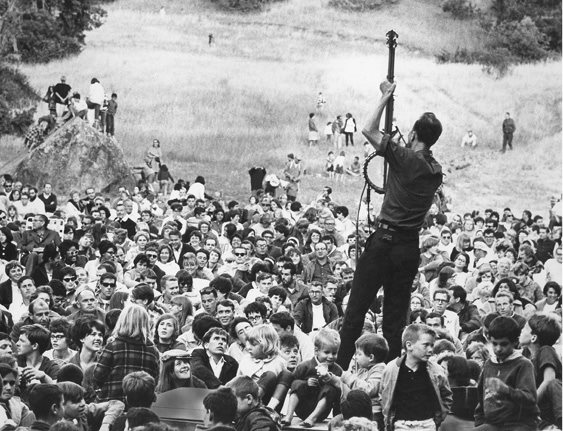I dedicate this book to you, the Reader,
with the greatest faith in your ability to understand what matters,
and to accomplish remarkable things.
A TRIANGLE SQUARE BOOK FOR YOUNG READERS PUBLISHED BY SEVEN STORIES PRESS
Copyright 2016 by Meryl Danziger
All rights reserved. No part of this book may be reproduced, stored in a retrieval system, or transmitted in any form, by any means, including mechanical, electronic, photocopying, recording or otherwise, without the prior written permission of the publisher.
Seven Stories Press 140 Watts Street New York, NY 10013 http:// www.sevenstories.com
Library of Congress Cataloging-in-Publica tion Data
Danziger, Meryl. Sing it! : a biography of Pete Seeger / Meryl Danziger. -- First edition. pages cm ISBN 978-1-60980-655-2 (hardcover) 1. Seeger, Pete, 1919-2014--Juvenile literature. 2. Folk singers--United States--Biography--Juvenile literature. I. Title. ML3920.S4D36 2015 782.42162130092--dc23
[B]2015024671
Teachers may order free examination copies of Seven Stories Press titles. To order, visit http://www.sevenstories.com/textbook , or fax on school letterhead to (212) 226-1411.
Book design by Jon Gilbert
Contents
If there is a world here in a hundred years, it will be because millions of people get involved in trying to save it.
Pete Seeger
This Pete Seeger Fellow
Participationits what all my work has been about.
Pete Seeger
T he party wasnt Pete Seegers idea. He was far too busy to think about his upcoming birthday. But Pete was turning ninety . Friends, family, and fellow musicians wanted to honor him, so they planned a celebration. Not to be held in someones living room, not even in a ballroom. So many people wanted to attend, and so many musicians were eager to participate, that the party had to be held at Madison Square Gardena huge arena where youd usually go to see the circus or a rock concert or a professional basketball game. The place was filled to capacity, and a television broadcast enabled millions to celebrate Petes birthday wherever they were, all over the globe.
So who was Pete Seeger?
A photo shows a tall, skinny guy wearing blue jeans and a wool cap. One hand holds a banjo. The other, with an energy all its own, reaches toward the sky.
If only there were sound to go with the photo, you would hearsinging! It was all about the singing. Wherever Pete was, you can be sure that there were voices raised in song.
I want to put songs on peoples lips, not just in their ear, he would say.
What kinds of songs would you sing with Pete Seeger? Folk songs. Songs written by everyday people about everyday things. Songs made by working people about mining coal or sailing ships or building railroads, to make the work go smoother and give it rhythm: Ive been workin on the rail-road! Songs that tell tall tales that may or may not have really happened: Old Dan Tucker was a fine old manwashed his face in a frying pan! Silly songs on serious subjects: Abiyo-yo, y-yo-yo, y-yo-yo! Songs to get people riled up or cheered up, or to give them hope: This little light of mineIm gonna let it shine! Songs about making the world kinder and more peaceful. Pete Seeger knew that songs, and singing them together, can inspire people to take action, and that a community of people taking action can change the world.
Pete often said, I look upon myself as a sower of seeds. Like a farmer sprinkling seeds throughout the field, he tried to sprinkle ideas wherever he went. He devoted his whole life to it. What set him on the path he chose? How did a boy named Peter grow up to be Pete Seeger? The story begins way back, long before you were born...
A Musical Beginning
Oh, let Peter enjoy himself!
Charles Seeger, Petes father
W hen the Mayflower sailed to America in 1620, one of Pete Seegers ancestors was on board. Almost three hundred years later, on May 3, 1919, Pete made his world debutnot as a banjo picker, but as a newborn in the home of Charles and Constance Seeger, his parents. Little Pete had good reason to believe that the universe was entirely made up of music. He was surrounded by it.
Petes father Charles was a university music professor and his mother Constance was a classical violinist. Constance wanted her first two sons, Charlie and John, to learn the violin. She tried giving them lessons, but they rebelled. Constance was not one to give up easily, and when Pete came along, she was ready to try again. His father had a different idea: Oh, let Peter enjoy himself! A happy decision, as it turned out. Petes parents left instruments around the house, and little Pete was able to spend time exploring and learning on his own.
He puttered with a pennywhistle, got acquainted with the autoharp, and squoze a squeeze-box. At age eight, Pete got a ukulele and figured out some chords. He taught himself pop songs of the 1920s and had a way of getting kids at school to sing while he played along. Pete and his brothers loved to sing in partshigh, low, and middleand belt out their harmonies at the dinner table. Every meal we sang our hearts out, recalled his brother John. Petes world was a musical place.
Early in his career, Petes father was interested in one kind of music: classical. Charles didnt just enjoy classical music. He believed in it, and felt sorry for people who never had a chance to hear it. Being a good-hearted and generous fellow, he made it his mission to bring classical music to the countryside. When Pete was just eighteen months old, Charles built something like a covered wagon pulled by a Model Ta spiffy car back then. He packed up the family and set off for the south. A surprise was in store.
The people the Seegers encountered may have been unfamiliar with classical music, but there was no lack of music in their lives! They were creating, singing, and playing their own songs: about work and play, happy times and sad times. Their music belonged to them and everyone participated in making it. This was a huge discovery for Petes father and he switched gears. Now, instead of only teaching about the music he already knew, Charles became a student, eager to learn as much as he could about this music that had grabbed hold of him: folk music. By contrast, Petes mother never wavered in her devotion to the Three Bs: Bach, Beethoven, and Brahms. And she never gave up hope that someday Pete would come around and get serious about studying good music.
Constance and Charles had many differences of opinion. Their sons musical education was just one of them. They drifted apart, and when Pete was about eight, his parents divorced.
When Pete was about thirteen, his father remarried. Charless second wife, Ruth Crawford Seeger, was one of the most important female composers of her time. Like Petes father, she became interested in folk music, and took up collecting and sharing childrens folk songs. Her book American Folk Songs for Children may be the most popular childrens song collection ever published.
Charles and Ruth had four children: Mike, Peggy, Barbara, and Penny, Petes half-siblings. The youngest Seegers had a nanny named Elizabeth Cottennicknamed Libba. As a child growing up in North Carolina, Libba absorbed the musical traditions of her African-American culture, taught herself to play banjo and guitar left-handed, and wrote her own songs. But when her church discouraged her from pursuing those activities, she gave them up.



